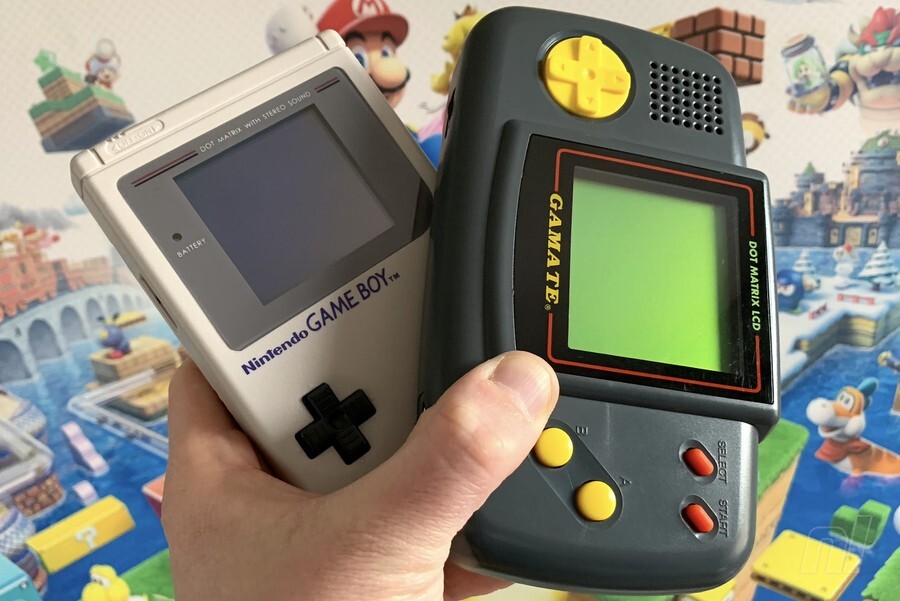
The Nintendo Game Boy turns 30 this Sunday, and to celebrate this amazing occasion we'll be running a series of related features this week, right up to the big day.
Context, they say, is for kings, and history can easily be misunderstood if we gloss over the specifics of how things relate to the time they're from. It’s easy, for example, to forget that kitsch and irony aren't modern inventions; kids today might listen to laughably quaint Beatles songs like ‘Yellow Submarine’ and ‘When I’m 64’ and get the false impression they were bleeding-edge sonic experiments in the mid ‘60s, rather than knowing pastiches. Context is vital to understanding the intention behind art and everything else – handheld video game consoles included.
 Watch on YouTube
Watch on YouTubeSubscribe to Nintendo Life on YouTube841k
Continuing our celebrations of the Game Boy on its 30th anniversary, we’re going to take a look at the handheld console landscape Nintendo entered and dominated for over a decade. Younger gamers today might look at the Game Boy and assume it was the best that could be achieved with the tech of the time, which couldn’t be further from the truth.
Technologically modest in the extreme, on paper the original Game Boy looks extraordinarily unremarkable up against the competition it would soon face. At launch, it was an underwhelming, underpowered device and critics scoffed at its insipid LCD screen and lack of backlight.
How, then, did it triumph, Little Mac-style, against clearly ‘superior’ competitors? In a game of Top Trumps the console wouldn’t win in too many categories and plenty of contenders stepped up for a shot at the handheld heavyweight title. We’re going to take a look at those challengers, some well-known, others not-so-much, and identify how the plucky Game Boy managed to overcome these brutes to win – and crucially retain – its Handheld Champion of the World belt through the 1990s.
First up, it’s a console that launched the very same year…
Atari Lynx
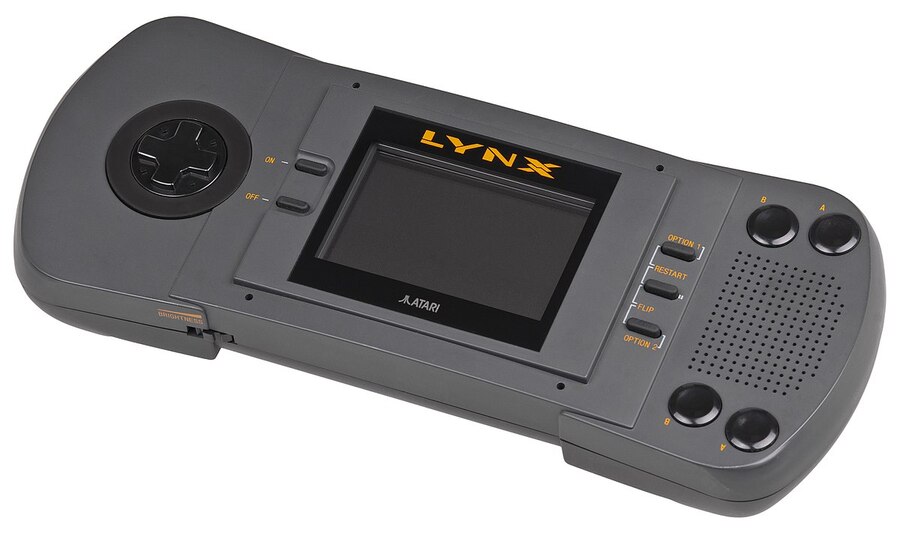
Originally developed as the ‘Handy’ by Epyx, the studio behind games such as Impossible Mission and California Games, the developer shopped the concept around to various companies at CES 1989. While some big names passed (including Nintendo, which obviously had its own imminent plans in the portable space), Atari signed up to produce and market the console. Epyx would soon fold, leaving Atari in total control. Rebranded as the Lynx, it launched with some success in September 1989 for $179.99.
As you can see, the initial version was a beast. It had a 160x102 screen with a 4,096 (12-bit) colour palette and you could play it in the dark without peripherals thanks to its backlit screen. Eight consoles could be linked for multiplayer shenanigans and it boasted big name titles that Nintendo fans would have recognised with Paperboy, Double Dragon and the afore-mentioned California Games – a pack-in with the console at launch. Klax, the console’s answer to Tetris (and a game which also appeared on Game Boy), was played by rotating the console 90° decades before we started flipping our Switches sideways.
It had issues, though. Although its ambidextrous design was impressive, its sheer size made it cumbersome to carry and poor battery life (4-5 hours with six AAs) coupled with a lack of quality titles to rival the long list appearing on Game Boy sealed its fate. A smaller hardware revision launched in 1991 featuring improved battery life, stereo sound and rubber grips, but by then the Game Boy had ascended to the handheld throne.
Overall, the Atari Lynx was a decent stab at a portable and still has its fans today, but it couldn’t compete with Nintendo’s offering and, technically speaking, it was outclassed by the next contender…
TurboExpress
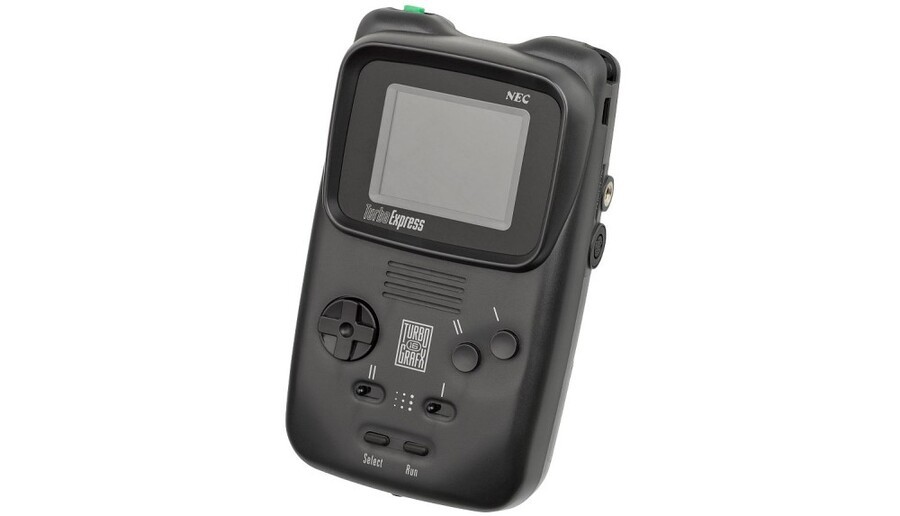
Featuring a vertical orientation, NEC’s TurboExpress (or PC Engine GT in Japan) looks like the lovechild of a Game Boy and a Garmin SatNav. Although the screen is roughly the same size as Nintendo’s portable, this one offered a palette of 512 colours with 400x270 resolution. The TurboExpress was a monster in tech terms; a portable TurboGrafx-16/PC Engine that ran the entirety of that console’s software library. That’s an enviable catalogue, to be sure, but unfortunately, playing with that much power had consequences when it came to power consumption. Six AA batteries would only buy you around three hours away from an electrical outlet.
It launched at the very end of 1990 for an eye-watering $249.99 – just shy of $500 in 2019 money – before jumping (temporarily) to $299.99 a few months later due to production costs. In 1992 it dropped to a more manageable $200, but a Game Boy with Tetris for $90 was a much more attractive proposition for all but the most dedicated gamers.
The substantial outlay to buy the hardware, plus the second mortgage required to finance 24 AA batteries every twelve hours, led to disappointing sales and NEC discontinued production in 1994. However misguided it was back in the day, it’s still a hugely impressive piece of kit all these years later. It’s arguable that only now with Switch do we finally have home console games on a portable at an affordable price – the TurboExpress was too far ahead of its time to be anything but a curio. Speaking of curios…
Bit Corp Gamate

No, the sexual reproductive cells you’re vaguely recalling from GCSE Biology are gametes – the Bit Corp Gamate was a Taiwanese, landscape-orientated Game Boy contemporary that appears to fuse the gametes of an OG DMG-01 and a GBA.
Bit Corp developed software for the Atari 2600 and also produced clone consoles of the Famicom and the Sega SG-1000, among others. Little is known concerning the specifics of the Gamate’s launch due to it being handled by different distributors in each territory, but it launched in the UK for a very reasonable £59.99, including a game.
Technically speaking, it’s not a million miles away from Nintendo’s console. Powered by four AA batteries, its 160x152 screen suffers from similar (if not worse) ghosting issues and problems in low light. For a more in-depth look at the machine, check out our editor Damien’s examination of the console and the story behind its release and software.
With a catalogue of about 70 games, most of them clones of more famous titles, it’s an amusing oddity for collectors and completionists, but the Gamate never really represented a credible threat to Game Boy’s dominance. The next challenger, however, was another matter entirely…
Sega Game Gear
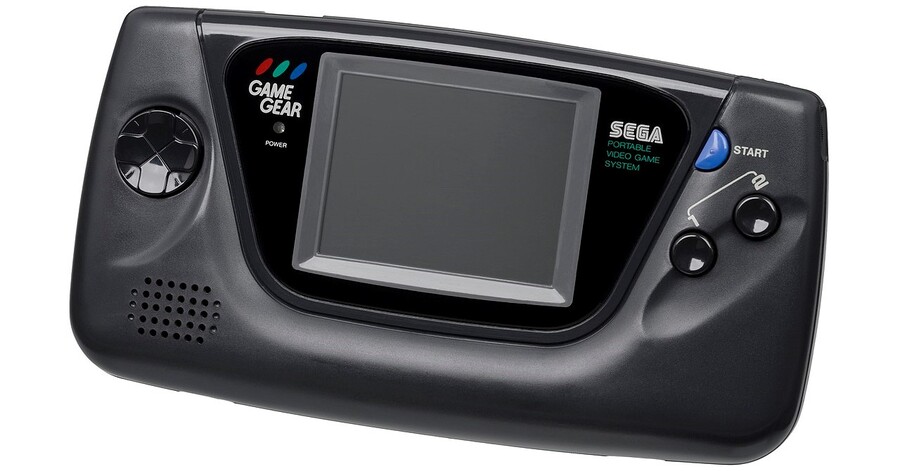
Ah, yes. Sega’s response to Game Boy at the height of the console wars, the horizontal Game Gear represented Nintendo’s arch nemesis doing everything Nintendidn’t – the good and the bad. Essentially a portable Master System with a lower resolution screen, it gave you up to 32 simultaneous colours on a bigger, backlit display, offering slightly cramped, slightly blurrier ports of Sega's 8-bit home console games. Launching in the US at $149.99, those benefits made it a tantalising proposition over the monochrome Game Boy, especially considering it featured Sega’s Mario-trouncing mascot, Sonic the Hedgehog.
However, as with nearly all of the Game Boy’s technically superior challengers, battery life was a real kicker. Similar to the TurboExpress, six AAs would get you 3 hours, maybe a little more. As impressive as the it might have been when directly compared to Nintendo's effort, it’s tough to show off your shiny Game Gear in the school playground when you’re tethered to the wall by an AC adaptor.
With Nintendo tying up third-parties left, right and centre, Game Gear owners found themselves with a mini Master System they could play anywhere… within three-feet of a plug socket. At the time, Sega was cranking out new home console hardware every five minutes, merrily imploding as a company and souring fans with repeated and expensive disappointments. The Sega Genesis Nomad – a portable Mega Drive – pulled off a similar trick with Genesis hardware but failed to address the power consumption issue and met with far less success, vanishing into relative obscurity amidst the mess of Sega add-ons and peripherals of the mid-1990s. Meanwhile, Game Boy marched ever onwards.
Watara Supervision
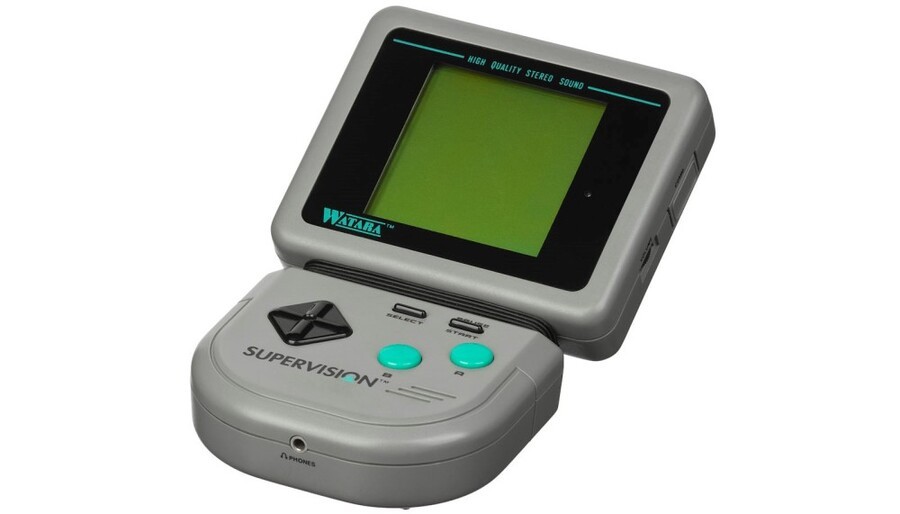
The Watara Supervision (or the Quick Shot Supervision in the UK) launched in 1992 for $49.95, a Game Boy alternative for anyone on a budget after a portable experience. It came in two forms – a rigid vertical console very similar to the Game Boy and one with a screen that was separate from the main body meaning it could be tilted. While technically similar to the OG Game Boy, its big gimmick was the ability to plug into a TV and play on the big screen. However, despite heavy marketing, especially in the UK, the console’s lack of software meant it died on the vine.
Hartung Game Master
Now we’re really getting into the weeds. The Hartung Game Master (or Systema 2000 in the UK) might have looked like a Game Gear, but it failed to measure up to even the Game Boy’s modest specs. Gamers first glimpsed its Tamagotchi-style visuals in 1990, apparently, but the console obviously didn’t take off.
With a two-tone 64x64 LCD screen and a D-pad that looks like somebody forgot it was needed until the last moment and just managed to jam it in before the mould clamped shut, we’ll leave you to watch the video above and come to your own conclusions as to why Nintendo didn’t lose any sleep over this competitor. The audio reminds us of an awkward Boxing Day evening a few years back following a particularly gluttonous dinner. Most embarrassing.
Mega Duck
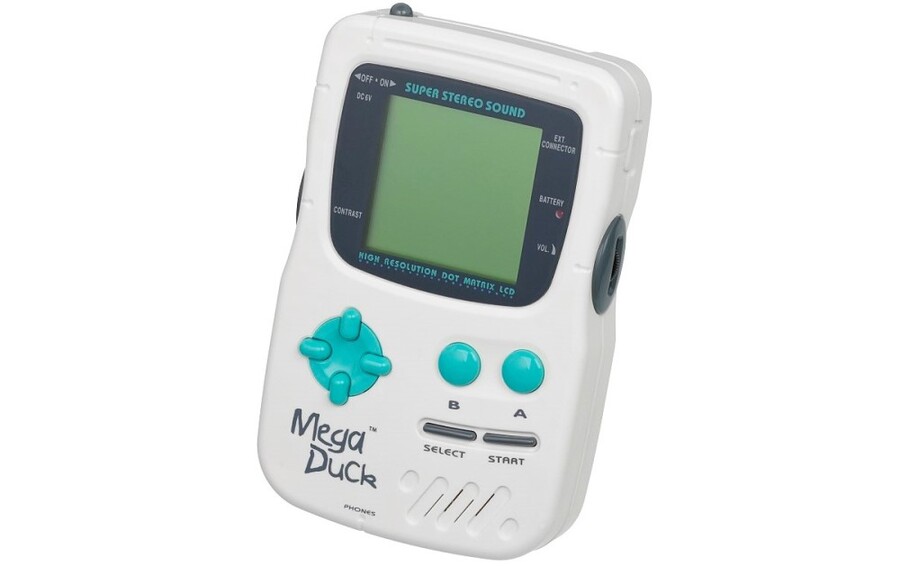
Our final ‘contender’ (okay, we’re really into the nosebleeds with the final three), the Mega Duck is a real piece of hardware, we promise. Also known – we’re not joking – as the Cougar Boy, it was produced in Hong Kong and marketed and distributed by different companies all over the world.
It's very similar to the Game Boy in both form factor and specifications, and actually performs rather well (better than the Game Master, that’s for sure). We’ve included it for the sake of completion, but you don’t need us to tell you how well this performed when it saw sporadic release in 1993. Check out this overview of the console from Ashens for more info on this oddity and its small library of games.
And that concludes our round-up of the upstart handhelds that tried to muscle in on the Game Boy's turf. We’ll forgive you if the last few also-rans never appeared on your radar, but there are some heavy-hitters in there. With no shortage of contenders for the handheld crown, in the end it came down to a combination of killer apps and - crucially - cost. These days portables come with inbuilt lithium-ion batteries, but running a portable system used to be like running a car. A constant supply of double-As would run up a substantial fuel bill and many players (especially kids) simply weren’t in the position to replenish spent batteries at the rate the best tech of the day demanded.
Nintendo was savvy enough to realise that, and downgrading every component to the barest minimum enabled the company to massively undercut the competition on store shelves as well. Throw in some incredible software development nous, a famous block-falling title from behind the Iron Curtain as a pack-in, and sequels to hot NES properties like Mario and the like, and Game Boy’s value proposition was more than enough to see off pretenders with cutting edge features like, you know, colour graphics and a screen you could actually see in anything other than direct midday sunlight.
With the dawn of the Game Boy Color in the late ‘90s, various other consoles would vie for the Nintendo’s portable crown. Systems like the WonderSwan (developed by Gunpei Yokoi, father of the Game Boy) and the Neo Geo Pocket Color had their merits, but none would seriously challenge the dominance of Nintendo in the handheld arena until the arrival of Sony’s PSP.
The design philosophy behind Game Boy has informed Nintendo’s entire hardware line across the home and portable arenas since the Wii days, and in spite of the odd stumble, its consoles continue to punch well above their weight thanks to canny design choices and innovative approaches to established tech. Nintendo has done very well to avoid many of the pitfalls of other hardware developers over the years and with rumours of Switch revisions in the air, we hope that continues for another thirty years, at least.





Comments 46
Come on, the Megaduck is an awesome name! And the Turbo express was amazing, if only it had more support. Also, game gear was a misunderstood hero
This gives me Ashens flashbacks and that's a good thing.
I am surprised they never mentioned the notorious Game.Com from Tiger. It was quite well known back in it's day along with the R-Zone for how awful they were. I actually got them off Ebay one day just for the novelty of having one, they truly live up to their reputation.
Even thinking back on how godawful the early color screen cellphones were battery-wise (compared to b&w contemporaries that didn't need a constant backlight) it's wild how long it took battery technology to catch up to where we needed it.
@JayJ The Game.com was more in competition with the GBC, not the original GB.
I've been eyeing up a back lit original Gameboy on eBay. Wouldn't mind a Game Gear with new screen either. Both are tempting me.
Game gear was awesome at the time.
The Game Master is new to me, which is saying something. Kudos.
Ah, the Game Gear. Just as big as a Switch, twice as thick, and the same amount of battery life. My dad's Game Gear was the first video game system I played on, with the 8-bit Sonic 2 being the first game I played. I also played Aladdin and The Lion King on there. We still have it today, just without the adapter and the screen being dead (it lights up but doesn't show anything, and I never got around to fixing it). I was ecstatic when they put Sonic 2 on the 3DS, and I would've loved it if the other two followed suit. Darn licensing gets in the way of that.
But what about the Game Child and the Game.com? Ashen even made a full length movie on the Game Child, don't tell me you choose to ignore that handheld masterpiece.
Further proof that more powerful system "specs" doesn't mean everything.
@Medic_alert Ha, I don’t need to jam a fiver’s worth of batteries into my Switch every three hours, though
@Medic_alert at least you can just plug it in after instead of sticking in another 10$ worth of batteries
Now THAT was a great article. Thank you, Nintendolife 😀
I'll always have a soft spot for the Game Gear. You could actually get an adaptor that let you play proper Master System games on it and the TV Tuner was incredible. I bet the BBC had fun tracking down licence evaders using that 😂
@Medic_alert and god help you if you plugged it in too soon or left it plugged in too long cause those nicad batteries were a hot mess.
my buddy in middle school had the tv tuner, but my parents reaction to that was "are you crazy?"
@retro_player_22 Game.com was much later than these and the Game Child deserves to be ignored! If you want to get technical, let’s say it was disqualified because it didn’t use interchangeable media. Like Game & Watch, but a really toilet one
Loved the lynx, just mainly because of California Games.
But you forgot about the GameGear having the tv adapter, which turned your game gear into a portable TV. Now that was amazing
Only one of these that I owned was the Game Gear. I can't believe people would buy one and not get one of Sega's rechargable battery packs, considering how the thing ate batteries. The real problem with it is that it didn't really have any killer games.
I'm a bit sad that I missed out on the Nomad, considering it was essentially a sort of proto-Switch: a handheld/home console hybrid all the way back in the 90's. SEGA had some really amazing hardware ideas: I still adore the Dreamcast's VMUs. What other company would have thought to turn their system's memory cards into miniature handheld gaming devices that interacted with the home console's games in unique ways?
@Bunkerneath
Yeah I bought a GameGear in the mid-1990's and kept it until my kids were old enough to play it in the early 2000's then I was able to pick up a car adapter, TV tuner, carrying case, and more games off of eBay. With the car adapter and AC cord, my son was able to make great use of it on vacations and road trips. Was a nice little gaming system.
I was a proud Game Gear owner - and yeah it was basically an AC adapter 'portable'. To this day, and to my shame. GG Sonic is the only Sonic game I've ever 100%'d. My Mum still owns it to this day and occasional plays some Columns on it.
i had a lynx and game gear. brother had a gameboy.
don't have any of em anymore. i miss my lynx. game gear/boy not so much. i still have a super-gameboy if i get the itch.
Had the Watara Supervision at one point. Not sure why, seeing as I already had the Game Boy. Regardless, Brickout on it was entertaining, and the industrial swivel-neck was...memorable.
My brother had the Game Gear and the Nomad. The GG just wasn't fun enough, although I enjoyed Sonic and Shinobi. The Nomad was fine but since I had a Mega Drive (Genesis) already, and I didn't fancy lugging the thing around with me, I never used it. The GameBoy ruled supreme!
Very nice article. One thing I never understood through the years is people saying you’d need 6 new batteries every 3-4 hours. To do that would be crazy - you just bought 6 rechargeables and a cheap charger and never have to spend another penny on batteries. Much cheaper than the Gameboy long term. Saying that I’d still have picked the Gameboy for the games.
How did the Megaduck not win with a name like that.
"Context is for kings". Nice Star Trek quote.
Great article. The Game Boy is the reason I prefer handheld gaming today.
@JayJ Game.com was, like everything Tiger did, far too late.
It was released in 1997, many years after people were demanding a color upgrade.
Funny that Tiger decided to rip off the VIRTUAL Boy before they decided to rip off the GAME Boy.
Also "This system plays more games than you idiots have brain cells." Way to advertise your product Tiger, tell your customers they have less than 20 brain cells.
Glad the neo-geo pocket wasn't included! That machine was dope!!
I loved the Lynx! It was way ahead of its time.
@Bunkerneath sega n there clunky ad ons. god no wonder they lost the war to nintendo
My brother and I had a Lynx, and a fair amount of games! It really was a great system, and there were some very seriously good games on it .
The Game Boy has always been the best example in my opinion of the idea that games sell hardware. Technology wise, the Game Boy was rather primitive, even for 1989, but the great games made on that basic hardware is what won it the glory it rightly deserves.
However despite the amazing nostalgic appeal, going back and playing games on any device without a backlight these days is just downright awful. I pushed through Pokemon Blue a few years ago on original hardware and even with the nostalgia factor, I usually ended up with a headache after each session.
I have fond memories of opening my OG Gameboy on Xmas of '89. It might of been low tech but I was amazed at the ability to play a Mario game anywhere. It made road trips fly by and I could play Nintendo at school. I ended up getting a Game Gear latter on, but it just wasn't as practical. I had to do most of my play time near an outlet, so it didn't feel nearly as portable as the Gameboy. A few years ago I picked up a backlit modded Gameboy Pocket and I love playing it once in a while for a nostalgia fix. Gameboy feels so quaint now in an era of super computers linked to the sum of human knowledge that fit in my pocket.
Of these four low volume entries:
Bit Corp Gamate,
Watara Supervision,
Hartung Game Master.
Mega Duck
Only the Mega Duck seems like a possible contender to the Game Boy. The others have horrible sound and low resolution screens comparatively speaking. The other portables are obvious well known players in the market and of those my personal opinion is the Game Gear had the best chance and nearly did make a decent run at the title but Sega had too many management issues to make this work. It is a shame they did not make it as the market could have supported two. I have both the Game Boy and the Game Gear and they each have their strengths and weaknesses.
one thing about having a 3ds or 2ds is you can play some classic portable games on those systems.
@Bunkerneath The Turbo Express also had a tv tuner! Portable tv’s have fallen out of favor for mobile phones.
https://upload.wikimedia.org/wikipedia/commons/thumb/f/fc/NEC-TurboExpress-wTurboVision.jpg/1024px-NEC-TurboExpress-wTurboVision.jpg
How did the Game Boy win? It had excellent exclusive titles that were developed with the system in mind (and not just mostly shovelware and downgraded console ports, although it had some of those, too).
There was Tetris, of course, it's where Kirby got his start, the Donkey Kong arcade game got an incredibly expanded remake, and it also received excellent exclusive handheld entries in the Super Mario, Zelda, Metroid, and Kid Icarus series (the latter arguably even better than the first game on the NES). Third parties chipped in with stuff like Mega Man and Castlevania. Finally, all of that is before Pokémon hit the scene and became a handheld sensation.
Nintendo is life.
My age mate the Nintendo game boy, I'm only older by some months 😁😁😁
The Lynx, TurboExpress and Game Gear were all genuine contenders, but they all had just one or two big issues that put them out of the running ultimately (usually price and battery life were the main culprits).
The TurboExpress is still a pretty dang impressive portable even today imo, and I would love to see a Classic/Mini version of it that was like half as thick (and slightly tweaked to tidy up any of the more clunky looking design elements) and had a modern screen and a hugely increased battery life. It could still take all the original PC Engine HuCards, which would just be cool, and also come with a selection of say 30 of the best TurboExpress games pre-installed too. I think that would actually be a brilliant little retro-portable package, and if they sold it for somewhere in the $50-$100 range, I think a lot of people would pick it up.
The Game Boy library of games is still one of my favorites. Simple fun games with no BS! 😃
I had (actually still have) an Atari Lynx. It was amazing when it came out. At the time, I didn't really think of the short battery life much. For me, the main goal of having a handheld wasn't really to take my video games with me everywhere. It was more about being able to play games without having a TV. Such as: in my bed room, any time my dad/brothers were watching football, or two years later in my dorm room. And while I agree with the people saying "Specs aren't everything" I still don't really see how anyone was content with the Game Boy. I think Tetris was the only game I actually enjoyed on that system. But it had the benefit of Nintendo's library and the Lynx really had to scrounge for games. And while its library was relatively small, it did have quite a few really good games.
I remember kids being jealous of my Game Boy and bragging how they were going to buy a Lynx or Game Gear instead because the screen was way better, but I never once saw anyone with anything other than a Game Boy. If they ever actually bought those systems, they sure didn't take them out in public.
I briefly owned a Supervision it wasn’t too bad.
Nice article. I had a Mega Duck...and wasn't very fond of it. I had the "moving boxes" game and a game with penguins, I believe.
Show Comments
Leave A Comment
Hold on there, you need to login to post a comment...